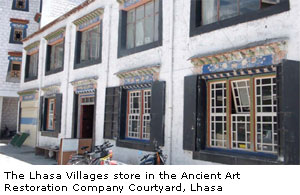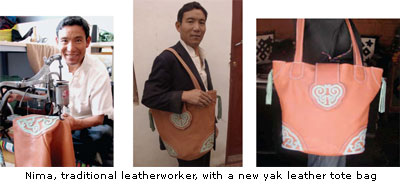
Meet “Lhasa Villages” in Lhasa, TAR
NGOs#11 Chak Tsal Gang Road
Lhasa
850000 PRC
Email: [email protected], [email protected], Lhasa, PRC, China 850000
E: [email protected] , [email protected]
W: org-website

|
| In the heart of the old Tibetan quarter in Lhasa, just a ten-minute walk from the Jokhang temple, is Lhasa Villages. Offering crafts made only by Tibetans, Lhasa Villages is a popular destination for tourists who want to purchase authentic Tibetan crafts such as textiles, painted wood boxes and trays, stone carving, leather bags, jewelry, carpets and dolls and toys. In 2010, Lhasa Villages was registered as a Tibetan-owned social enterprise whose profits are re-invested into further support of the Tibetan artisan community.
Lhasa Villages markets its hand-crafted products under the brand name “Dropenling.” The Tibetan word “Dropenling” means “giving back for the betterment of all sentient beings”, and the work of Lhasa Villages has benefited Tibetan craftspeople all over the Tibet Autonomous Region (TAR). Although many products in Lhasa and internationally are marketed as Tibetan, most Tibetan style products (such as prayer wheels, jewelry and clothing) are actually manufactured outside the TAR by non-Tibetan peoples. Less familiar with enterprise development and competitive marketing, Tibetan artisans are facing difficulty earning income from their crafts skills. This is why Lhasa Villages helps not only to market Tibetan products through its Lhasa store, but also through the e-commerce site, www.tibetcraft.com. Dropenling brand products can also be found at Shangri-la Tang Tong Handicrafts center in the Tibetan town of Yunnan named Zhongdian (popularly known as “Shangri-la”).
|
| Product Design Lhasa Villages has its own product development staff whose workshop is located above the store. These experienced staff members design new innovative, culture-based products and also facilitate new designs created by the artisans themselves. Tengyal’s sense of fun has led him to specialize in designing toys: he has designed a hat with the fur and ears of a yak, a two-headed toy yak that serves as a pillow, and a small bank in the form of a Tibetan house. He also has befriended a stone carver who appreciates extending his range of carvings beyond traditional mani stones—with Tengyal’s help he now makes Buddha-shaped incense holders, coasters with auspicious symbols, and dishes for soap. Meanwhile, Tennor, who also takes care of raw material purchase, has helped three brothers who are traditional leatherworkers to bulk purchase yak leather from a local factory. Passang is in charge of artisan relations, and spends much of her time listening to artisans about their needs, explaining orders and checking quality. She works closely with the apron and carpet weavers located in communities near Shigatse. Her efforts have led to new lines of products made with traditional Tibetan apron cloth. Skills training Lhasa Villages conducts regular training workshops in skills revival and new design. Some of these workshops are described here. Doll and Toy making led by Susie Vickery, a professional costume designer who lives in London and Bombay. Susie worked with a group of seven tailors to develop dolls who wear the clothing from different regions of Tibet. There is also an amusing baby doll named “Olo” who wears a brocade jacket, pants with the typical split in the back, and his hair tied up in bunches. In addition the group created a most unique and lovable snow lion as well as a winsome tiger, both of which are now sold in Museum shops in the US and Europe.
|
| Natural dyeing. One of Lhasa Villages main activities has been to reintroduce natural dyeing into contemporary textile production, and in particular the carpet weaving tradition of Wangden valley. Originally a lama taught men of the Wangden valley to weave meditation carpets, and only men were allowed to weave them. Lhasa Villages supports continuation of this unique tradition and is working to improve the quality of the carpets through use of high-quality wool and natural dyes that include madder, rhubarb, indigo and walnut. Similar support is being provided to women apron weavers near Shigatse.
Leather craft
|
The UNESCO Award of Excellence  In 2010 Lhasa Villages submitted the products of wood painter Phurbu and toy and doll maker Lhakpa for the prestigious UNESCO Award of Excellence.. Products are reviewed according to key criteria: excellence in craftsmanship; authenticity; innovation; marketability; eco-friendliness; and social responsibility. Phurbu’s set of three trays with a fish motif and Lhakpa’s snow lion line of products received the award.Business development and market trends training In 2010 Lhasa Villages submitted the products of wood painter Phurbu and toy and doll maker Lhakpa for the prestigious UNESCO Award of Excellence.. Products are reviewed according to key criteria: excellence in craftsmanship; authenticity; innovation; marketability; eco-friendliness; and social responsibility. Phurbu’s set of three trays with a fish motif and Lhakpa’s snow lion line of products received the award.Business development and market trends training 
Through Lhasa Village’s effort to empower Tibetan artisans, many artisans have gained the knowledge and confidence required to run and expand their own small enterprises. In particular, women master weavers are now hiring other weavers so that they can increase production. Lhasa Villages has helped the weavers to calculate income and expenses, develop employment policies, plan production, cost products and improve management. For instance, Sonam Drolma who weaves belts that are then sewn together to make placemats, had never calculated how long it might take to produce Lhasa Village’s winter order of 100 pieces. The business training team worked with her to plan how many weavers she needed to employ to produce the order in time for the tourist season.
Other inquiries may be made to: Tashi Renchen Tseba (Marketing Manager, Lhasa and Shangri-la): [email protected] Kristine Jones (Sales Representative, USA): [email protected] Lhasa Villages, #11 Chak Tsal Gang Road, Lhasa, Tibet, 850000, China |





